
What does the world’s most ambitious fighter program meet when confronted with work stoppages and technical ambiguity? For Boeing, the Pentagon, and the entire defense industry, the answer has the potential to shape America’s future air power.

1. Labor Turbulence Threatens F-47 NGAD Timelines
A threatened strike by over 3,200 union employees at Boeing’s facilities in St. Louis has hung a dark shadow over the F-47 Next Generation Air Dominance (NGAD) programme. The International Association of Machinists (IAM) Local 837 turned down Boeing’s 20 percent four-year compensation package and $5,000 bonus proposal, calling for a seven-day cooling-off period prior to a potential work stoppage.

The union sent a message: “IAM Union members sent a strong message: the Boeing Defense proposal lacked responding to the priorities and sacrifices of the skilled IAM Union workers.” Our members are uniting to fight for a contract that values their contributions and guarantees a secure future.” Unless an agreement is struck, a strike would commence on August 4, halting production of the F-47 and other defense projects at the St. Louis factory, which is vital to the country’s defense.

2. The Stakes: Pentagon Readiness and National Security
Delays in the F-47 program would have implications much greater than Boeing’s bottom line. The F-47 is meant to replace the old F-22 Raptor, which gives the U.S. Air Force a sixth-generation fighter to counter China and Russia’s next-level threats. “We are not just producing another fighter,” declared Air Force Chief of Staff Gen. David Allvin. We are defining the future of war and putting our competitors on notice.” The sense of urgency at the Pentagon is real, with the F-47 being touted as “the world’s first manned sixth-generation fighter, built to overmatch the most advanced peer adversary and fight in the most capable threat environments conceived.” Delaying it would undermine America’s dominance of the skies at a moment when competitors are ramping up their own programs and probing American will.

3. Boeing vs. IAM: Contract Negotiations and Industry Precedent
The St. Louis standoff is not just about a raise. IAM members invoke inflation, health care costs, and job security issues left on the table. Boeing, on its side, says it has presented IAM 837 with its “most lucrative contract ever” and has “employed our contingency plan and preparing to prepare for a strike.” The conflict is part of a larger pattern of U.S. manufacturing in which high-skilled employees are flexing their muscle as demand for cutting-edge aerospace products grows. Analysts add that although defense division employment is lower than Boeing’s commercial business, the strategic effect of a sustained strike is disproportionate, potentially sidelining military modernization and compelling the Pentagon to re-award future contracts if reliability is at stake.

4. The White House and Pentagon: Will They Step In
Since the F-47 program is a national security concern, White House or Pentagon intervention is a strong likelihood. President Trump, announcing the F-47 contract in typical bravado “No other airplane in the world even comes close. The generals picked the name F-47, a lovely number” can pressure both sides to come to an agreement. Labor law analyst Michael Duff said, “I think it’s unlikely that the president would just sit around in the face of a labor dispute like this.” I believe the president would put as much pressure as it’s believed he is able to do now, and then perhaps attempt to put even more pressure than that on. The role of the administration would be to create a precedent for future defense labor wars, particularly because Boeing competes on other programs like F/A-XX and Navy NGAD.

5. F-47 NGAD: Engineering Ambition and Supply Chain Challenges
The F-47 is not yet another fighter it’s a leap in design and integration. With “stealth++” capabilities, over 1,000 nautical miles of combat radius, and modular architecture for easy upgrades, the F-47 can penetrate deep into enemy air space. Its role as an uncrewed Collaborative Combat Aircraft (CCA) command node is a new generation of manned-unmanned teaming. But it is a goal that is complicated by the reality that it requires precision machining, new materials, and a good supply chain. Dependence by the program on next-generation adaptive propulsion systems already has been delayed, with the timeline for the engine falling as far as two years a “double disaster” coupled with labor disruptions.

6. Comparative Context: NGAD vs. Global Competitors
Although the F-47 will surpass China’s J-20 and J-35A, America must not be complacent. Chinese advances in stealth, ballistic missiles, and anti-aircraft technology have increased the cost of American air supremacy. As explained by Major General Joseph Kunkel, “There was no more viable option than NGAD to achieve air superiority in this highly contested environment.” The strategy of the Air Force to use fewer manned F-47s and more than 1,000 CCAs is a leap toward networked, distributed warfare a model requiring technological dominance as well as industrial capability for ensuring a crushing edge.

7. Financial and Industrial Implications for Boeing
Boeing’s defense business, though smaller than the commercial business, is a strategic support column while the company battles past losses. The F-47 contract worth about $20 billion is a cash cow for the St. Louis facility and the defense business as a whole. However, a strike would run at a cost of $100 million per day, with a shutdown of 60 days costing an estimated $6 billion. Boeing’s shift to cost-plus contracts and better risk management has leveled out margins, but Boeing’s performance in producing the F-47 will be watched by investors, the Pentagon, and Congress as a test of industrial vigor.

Where labor, technology, and national security converge in the F-47 NGAD program is a high-stakes crucible for Boeing and the U.S. defense complex. Time runs down toward a potential strike, the result of which will echo far beyond St. Louis determining the next decades of American air power.


